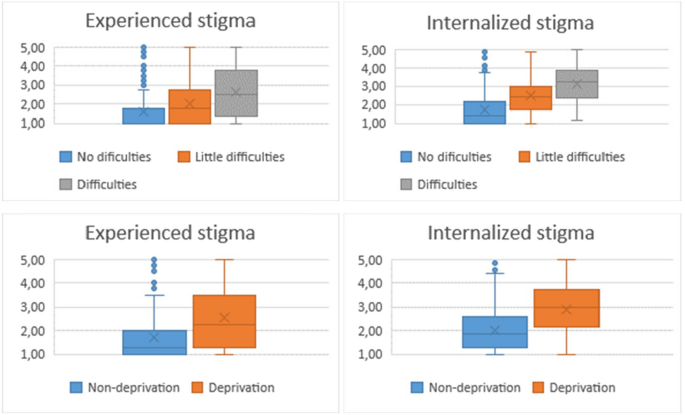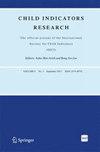Poverty as a Driver of Stigma among Finnish Children during the Covid-19 Pandemic– Evidence from the 2021 Children’s Voice Survey
IF 2.1
3区 社会学
Q1 SOCIAL SCIENCES, INTERDISCIPLINARY
引用次数: 0
Abstract
Abstract Stigma is a social problem that can have severe outcomes on both individuals and society. Previous research shows that children’s experiences of stigma may increase during times of stress and hardship such as the Covid-19 pandemic, but also that poverty and a lack of resources can create stigmatization. However, both stigma and poverty are multidimensional phenomena that have been investigated mainly among adults using single indicators. This article contributes to literature by studying children’s experiences of stigma and its relation to poverty by using a multidimensional approach. More specifically, it investigates Finnish children’s experienced and internalized stigma during the second year of the Covid-19 pandemic, and analyses how these dimensions are associated with subjective poverty and material deprivation. We use data from the 2021 Children’s Voice survey conducted by Save the Children, Finland. The results show that both dimensions of stigma are correlated with subjective poverty as well as material deprivation, even when controlling for socio-economic and other variables. Also low psychological wellbeing is a significant driver of both forms of stigma, while living in a one-parent household was significantly associated with internalized stigma, but not experienced stigma. By contrast, while higher self-esteem seem to reduce both forms of stigma, a higher number of good friends was found to only reduce experienced stigma. As there are both short- and long-term negative outcomes of stigma, for example in terms of mental health problems and social exclusion, child poverty should be taken seriously – especially during times of crises such as pandemics.

2019冠状病毒病大流行期间,贫困是芬兰儿童污名化的驱动因素——来自2021年儿童之声调查的证据
污名是一个社会问题,可能对个人和社会产生严重后果。先前的研究表明,在2019冠状病毒病大流行等压力和困难时期,儿童的耻辱经历可能会增加,但贫困和缺乏资源也会造成耻辱。然而,耻辱和贫穷都是多维现象,主要是在成年人中使用单一指标进行调查。本文通过使用多维方法研究儿童的耻辱经历及其与贫困的关系,为文学做出了贡献。更具体地说,它调查了芬兰儿童在2019冠状病毒病大流行的第二年经历和内化的耻辱,并分析了这些方面如何与主观贫困和物质剥夺相关联。我们使用的数据来自芬兰救助儿童会进行的2021年儿童之声调查。结果表明,即使在控制社会经济和其他变量的情况下,耻辱的两个维度都与主观贫困和物质剥夺相关。此外,低心理健康水平是两种形式的耻辱感的重要驱动因素,而生活在单亲家庭与内化耻辱感显著相关,但与经历的耻辱感无关。相比之下,虽然更高的自尊似乎可以减少这两种形式的耻辱,但研究发现,更多的好朋友只会减少经历过的耻辱。由于耻辱有短期和长期的消极后果,例如在精神健康问题和社会排斥方面,儿童贫穷问题应得到认真对待,特别是在流行病等危机时期。
本文章由计算机程序翻译,如有差异,请以英文原文为准。
求助全文
约1分钟内获得全文
求助全文
来源期刊

Child Indicators Research
SOCIAL SCIENCES, INTERDISCIPLINARY-
CiteScore
4.90
自引率
14.30%
发文量
103
期刊介绍:
Child Indicators Research is an international, peer-reviewed quarterly that focuses on measurements and indicators of children''s well-being, and their usage within multiple domains and in diverse cultures. The Journal will present measures and data resources, analysis of the data, exploration of theoretical issues, and information about the status of children, as well as the implementation of this information in policy and practice. It explores how child indicators can be used to improve the development and well-being of children. Child Indicators Research will provide a unique, applied perspective, by presenting a variety of analytical models, different perspectives, and a range of social policy regimes. The Journal will break through the current ‘isolation’ of academicians, researchers and practitioners and serve as a ‘natural habitat’ for anyone interested in child indicators. Unique and exclusive, the Journal will be a source of high quality, policy impact and rigorous scientific papers. Readership: academicians, researchers, government officials, data collectors, providers of funding, practitioners, and journalists who have an interest in children’s well-being issues.
 求助内容:
求助内容: 应助结果提醒方式:
应助结果提醒方式:


